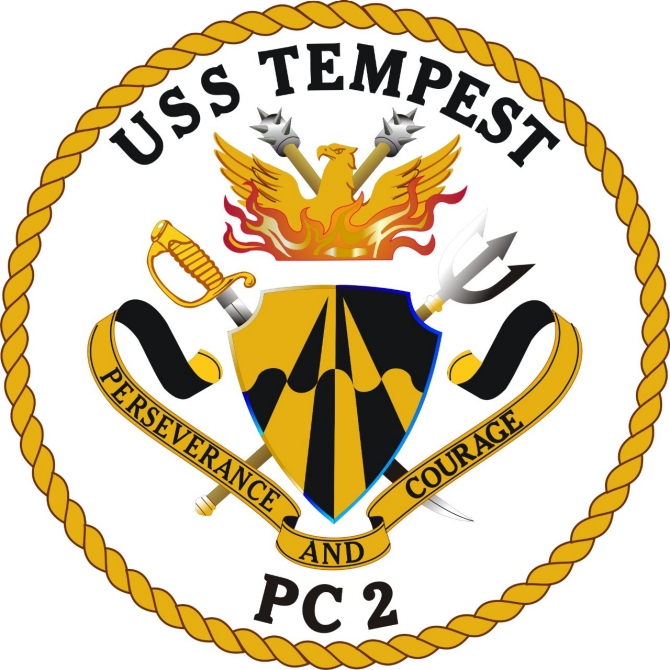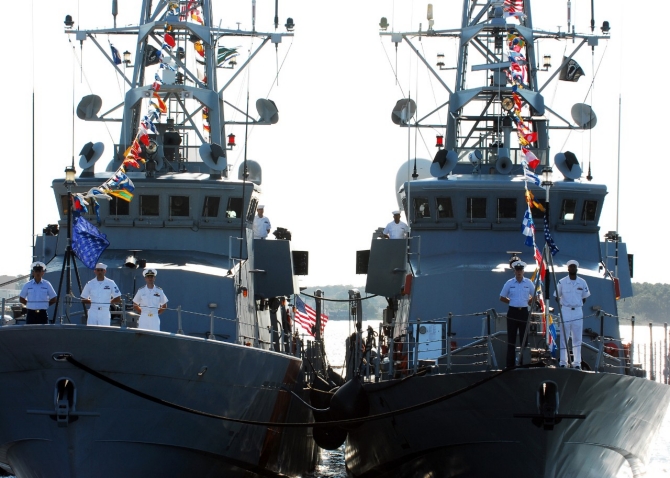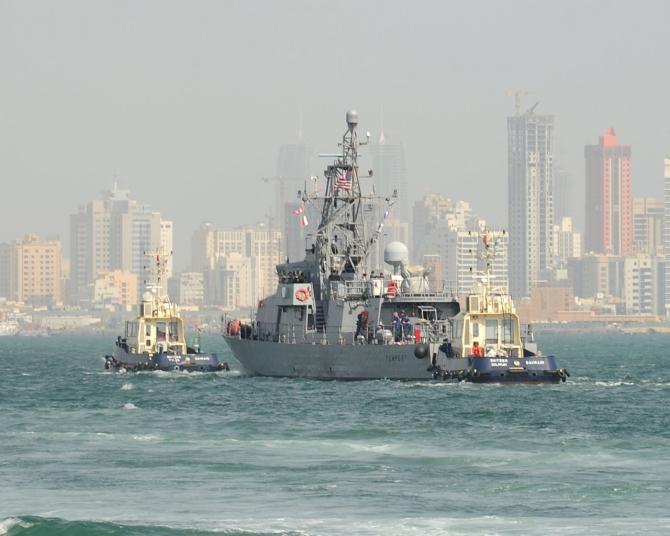Tempest III (PC-2)
1993-
A violent windstorm that is often accompanied by rain, snow, or hail.
The third U.S. Navy ship named Tempest. The first Tempest, a side wheel steamer, served briefly in 1865. The second, a shallow-draft, single-turret monitor, was laid down as Yuma in 1865, renamed Tempest on 15 June 1869, reverted to Yuma on 10 August of the same year, and served from 1865-1874.
III
(PC-2: displacement 334; length 178'; beam 25'; draft 8'; speed 32 knots; complement 30; armament 2 25 millimeter, 2 40 millimeter grenade launchers, 2 .50 caliber machine guns, and 2 7.62 millimeter machine guns; class Cyclone)
The third Tempest (PC-2) was laid down on 30 September 1991 at Lockport, La., by Bollinger Machine Shop and Shipyard; launched on 4 April 1992; sponsored by Mrs. Sara Livingston, wife of Maj. Gen. James E. Livingston, USMC; and commissioned on 21 August 1993 at Naval Amphibious Base Little Creek, Va., Lt. Cmdr. Henry C. Smith in command.

Shield
Gold and blue represent the U.S. Navy. The wavy fess refers to the sea and alludes to the turbulence of a tempest. The piles refer to the mission of coastal patrol, suggesting searchlights and radar surveillance. The gold and blue division of the shield refers also to the ship’s day and night capabilities.
Crest
The maces stand for forceful authority and refer to the two ships, past and present, to carry the name Tempest (the design of the crest does not account for the lineage of the three ships named Tempest). The phoenix represents the rebirth of the ship as Tempest (PC-2).
Supporters
The trident, adapted from the Naval Special Warfare insignia, is crossed with a Navy sword and refers to the ship’s mission of providing support for special warfare operators.
Following the Haitian Army’s overthrow of President Jean-Bertrand Aristide in September 1991, a succession of governments led to sectarian violence, and in May 1994 the military installed Supreme Court Justice Emile Jonassaint as Haiti’s provisional president. The UN authorized force to restore order and the U.S. initiated Operations Support Democracy and Uphold/Restore Democracy: Uphold Democracy for a peaceful entry into Haiti, and Restore Democracy in the event of resistance.
Tempest steamed from Little Creek in company with Cyclone (PC-1) on 24 May 1994, and patrolled the Haitian coast for over three months during Support Democracy as the Haitians agreed to allow the Americans to land peacefully, operating at times with Sea, Air, Land (SEAL) Teams 4 and 8 and Special Boat Unit 20. On 6 July, amphibious assault ship Inchon (LPH-12) sailed from Norfolk, Va., in response to the crisis. Wasp (LHD-1) relieved Inchon in Haitian waters on 17 August. The crisis escalated the following month, however, prompting an enlarged response by a multinational force that included aircraft carriers America (CV-66) and Dwight D. Eisenhower (CVN-69). About 1,800 soldiers of the Army’s XVIII Airborne Corps embarked on board Dwight D. Eisenhower. The U.S. transferred peacekeeping functions to international forces on 31 March 1995.
The Coast Guard acquired five of the Navy’s Cyclone-class patrol boats beginning on 1 October 2004. The Coast Guard initiated the action because of its aging fleet, increased operational hours following the terrorist attack on 9/11, delays in delivery of the converted 123-foot patrol boats, and the continued deployment of 110-foot cutters to the Arabian Gulf, all of which created a gap in patrol boat availability. The transfer immediately lessened shortfalls in patrol boat hours. The Navy and Coast Guard signed an agreement in August 2004 that allowed five ships to be under the operational command of the Coast Guard. Two of the five ships were scheduled to be returned to the Navy in 2008; the remainder in 2011.
Coast Guard Pacific Area and the U.S. Pacific Fleet jointly announced on 5 November 2001, the assignment of two Cyclone-class ships, Monsoon (PC-4) and Zephyr (PC-8), in support of the nation’s homeland security along the U.S. West Coast as a part of Operation Noble Eagle, where they operated under the tactical control of the Coast Guard Pacific Area command. Operational control of the ships, normally assigned to Special Operations Command through Commander, Naval Special Warfare Command, shifted to the Pacific Fleet. Three other Cyclone-class ships, Shamal (PC-13), Tempest, and Tornado (PC-14) were to be assigned to the U.S. Atlantic Fleet for maritime homeland security operations, and home ported at Pascagoula, Miss.
The Memorandum of Understanding directed the Navy to retain ownership as well as the responsibility for all life cycle management/maintenance, depot management, and casualty corrective service through 2008. The Coast Guard assumed the “responsibility for crew assignment, cutter funding, retrofitting, operation and management.” Tempest was decommissioned and transferred to the Coast Guard, which reclassified her as WPC-2, on 30 September 2004. The Coast Guard operated her until 22 August 2008, when she was returned to the Navy.


Detailed history under construction.
Mark L. Evans
7 July 2015


